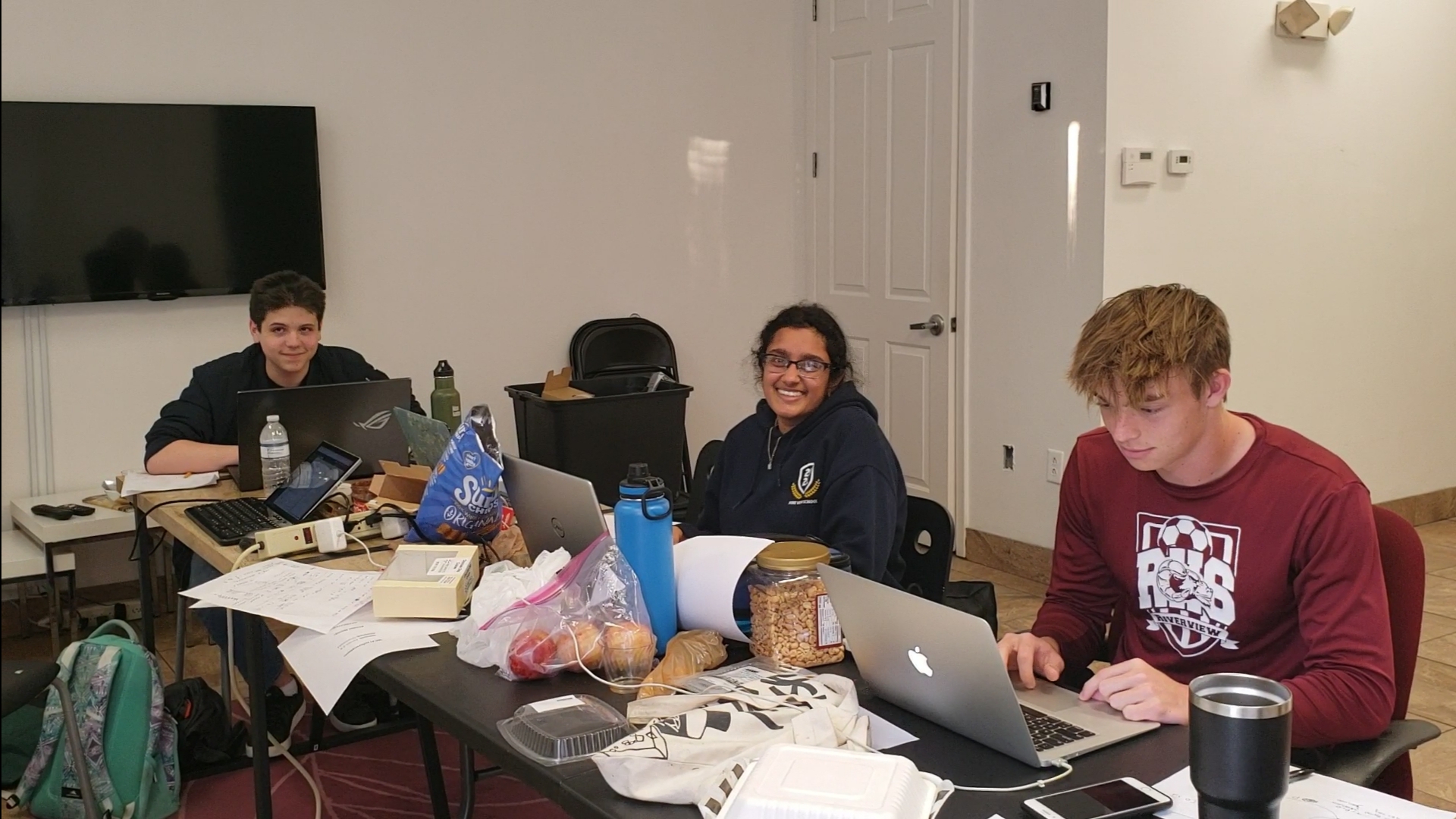Florida Students Recognized for Mathematical Model to Forecast the Implementation of Electric Semi-trucks
More than 1.7 million semi-trucks transport nearly every type of imaginable cargo across the country, often from manufacturing plants to retail distribution centers. The continuous movement of raw materials, finished goods, and miscellaneous freight bolsters the economy and keeps society running smoothly. As a result, nearly 7.5 million Americans hold jobs that are related to the trucking industry.
Diesel fuel currently powers semi-trucks, which collectively travel an estimated 150 billion miles each year. Unfortunately, these tractor trailers are not known for their fuel efficiency; they average less than seven miles per gallon and are responsible for roughly one third of transport-related carbon emissions. As battery electric vehicles become increasingly popular, the trucking industry is beginning to explore the viability of electric trucking. Tesla plans to introduce a line of electric semis in 2021, and PepsiCo, Walmart, and UPS have pledged to purchase several hundred. However, more infrastructure is needed to determine whether electric semi-trucks will meet current trucking demands and serve as feasible replacements for traditional diesel vehicles.
“Trucking is a very modest business,” Mike Roeth, executive director of the North American Council for Freight Efficiency (NACFE), said. “We go about getting everything consumers need and want to stores and homes without getting in the way. But trucking is also very complicated due to the many truck configurations, types of freight, and duty cycles, so it requires mathematical modeling to help figure out the details.”

The complexity of a potential transition to electric power in U.S. semi-trucks served as the basis for the 2020 MathWorks Math Modeling (M3) Challenge, an annual competition for high school juniors and seniors. The contest, which is organized by SIAM and sponsored by MathWorks, invites U.S.-based teams of three to five students to address a multi-layered, real-world problem via mathematical modeling and submit their results in just 14 hours. After two meticulous rounds of online judging by nearly 150 Ph.D.-level mathematicians, six finalist teams emerged. The third and final round of judging—traditionally held in New York City so the top teams can present their work in person—occurred virtually this year due to the ongoing COVID-19 pandemic. Participating students competed for $107,500 in scholarship funds, which was ultimately split among the six finalist teams and 32 other top performers.
The three-part Challenge problem asked teams to create a mathematical model to predict the percentage of electric semi-trucks in 2025, 2030, and 2040; calculate the required number of stations and chargers along five different U.S. truck routes to support the current level of traffic; and rank the five trucking corridors to determine which should undergo development first. Neil Nicholson (North Central College) authored the problem, with input from Roeth at NACFE and the M3 Challenge Problem Development Committee, which is led by Karen Bliss (Virginia Military Institute).
“This country depends on trucks to move goods around, now more than ever,” Bliss said. “Our infrastructure is built around this mode of transporting goods, and yet it’s relatively inefficient. A switch to electric trucking seems to be an attractive option, but there are a lot of barriers to converting an entire fleet of trucks.”
This year’s first-place team, from Pine View School in Osprey, Fla., began by dividing semi-trucks into three categories: long-haul, regional-haul, and short-haul vehicles. They calculated overall operating costs for both diesel and electric trucks based on existing data, then assumed purchasing costs from the current prices of cab and sleeper semis, as well as base prices for Tesla electric semi-trucks. The students used the differences in operating and purchasing costs to derive the probability values of replacing diesel trucks with electric trucks.
Next, they created three Markov chains—one for each type of truck—to predict the percentage of electric semis in future years. “To execute the three Markov chains, we utilized MATLAB software and determined the best estimate of the number of inoperable semi-trucks that would be replaced by electric ones in five, 10, and 20 years,” Pragnya Govindu of Pine View said. “With these values, we ultimately predicted the percentage of semis that will be electric.” The team’s model forecasts that electric semi-trucks will comprise 27.39, 69.49, and 97.77 percent of operational semi-trucks in the next five, 10, and 20 years respectively.
The Pine View students then generated another model to discern the mandatory quantity of charging infrastructure for sustainable, large-scale electronic trucking. This task demanded consideration of electric vehicles’ varying ranges and charging times. “Electric vehicle batteries are tricky because they charge quickly in the beginning but slowly at the end,” team member Michael Gutierrez said. “We didn’t want the trucks to use their full charge capacity, as it would waste a lot of time. So we developed a model to find the optimal stopping interval and based our charging station locations around that.”

To test their model, the group simulated the resource needs of a large fleet of trucks on the following five major trucking routes: to/from (i) San Antonio, Texas, and New Orleans, La.; (ii) Minneapolis, Minn., and Chicago, Ill.; (iii) Boston, Mass., and Harrisburg, Pa.; (iv) Jacksonville, Fla., and Washington, D.C.; and (v) Los Angeles, Calif., and San Francisco, Calif. “Initially, we created a formula for the number of stations needed along a given route,” Nicholas Butakow said. “With this formula, we used the Monte Carlo method to determine the number of stations with randomly generated values, which reflect projected distributions of commercial electric semi-trucks.”
Interestingly, Butakow and his teammates found that all five truck routes required charging points roughly every 90 minutes, given the nature of electric batteries. They used a second Monte Carlo simulation—based on the average number of trucks present at each stop at any given time—to determine the necessary number of charging stations per stop, which ranged from 14 to 29.
Finally, the team created an importance score based on three different factors—economic growth, environmental consideration, and total cost of installation—to rank the five corridors. A higher importance score indicated a higher priority for projected development, and the students determined that developers should target the Minneapolis-Chicago corridor first.
The Pine View team—which included Kristoffer Selberg and Christiana Guan, in addition to Govindu, Gutierrez, and Butakow—will split $20,000 in scholarship funds for their winning solution. The group also nabbed an Outstanding Communication of Results Award, which recognized the excellence and clarity of their video demonstration (submitted in lieu of a physical presentation) and delivered an additional $1,000.
“It was really different because we had to work over Zoom instead of communicating and presenting in person, which was difficult,” Guan said. “But being able to use visuals—which likely wouldn’t have been as possible during an in-person presentation—was helpful.”
Working together under stringent time and resource constraints provides participating students with unique collaborative modeling experience — much like the type of projects that computational scientists and professional mathematicians tackle in the real world. In addition to showcasing the vast potential of a career in applied mathematics, M3 Challenge illustrates the practical applicability of mathematical modeling as an acute problem-solving tool, something that most students do not experience in the traditional classroom setting.
“Typically, the math education that I get in school rigorously teaches the fundamentals of mathematics,” Selberg, who is interested in pursuing a career in applied mathematics, said. “M3 Challenge takes what students have learned in school and provides a platform for the expression of mathematics in unique ways that are rarely exhibited in classrooms today.”
Pine View School’s winning paper is available online, as is their final presentation.
About the Author
Lina Sorg
Managing editor, SIAM News
Lina Sorg is the managing editor of SIAM News.

Stay Up-to-Date with Email Alerts
Sign up for our monthly newsletter and emails about other topics of your choosing.



